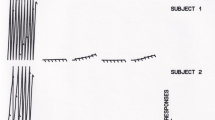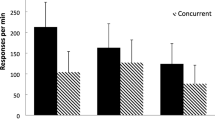Abstract
Two experiments extended the investigation of temporally defined avoidance schedules to human Ss responding on a schedule of point-loss avoidance. Experiment I found that superimposition of a td-correlated added stimulus had no effect on response rate or distribution, while response-cost contingency of 1 point per response produced a decrease in response rate and an increase in failures to avoid 10-point losses. Discriminated responding was produced only by combination of the added stimulus and the response-cost contingency. Experiment II found that a high-effort response mani-pulandum was functionally equivalent to the response-cost contingency in behavioral effects. The results are consistent with Weiner’s explanation for apparent insensitivity of human responding to nonresponse contingency events and support the generic use of the term “cost” in exchange theories.
Similar content being viewed by others
References
AZRIN, N. H. 1958. Some effects of noise on human behavior. Journal of the Experimental Analysis of Behavior, 1, 183–200.
BLACK, R. E., WALTERS, G. C, & WEBSTER, C. D. 1972. Fixed-interval limited-hold avoidance with and without signalled reinforcement. Journal of the Experimental Analysis of Behavior, 17, 75–81.
CLARK, R. 1959. Some time-correlated reinforcement schedules and their effects on behavior. Journal of the Experimental Analysis of Behavior, 2, 1–22.
DUNN, M. E., FOSTER, W. S., & HURWITZ, H. M. B. 1971. Effects of cycle length on performance on a temporally defined avoidance schedule. Journal of the Experimental Analysis of Behavior, 16, 263–268.
FARMER, J., & SCHOENFELD, W. N. 1966a. Varying temporal placement of an added stimulus in a fixed-interval schedule. Journal of the Experimental Analysis of Behavior, 9, 369–375.
FARMER, J., & SCHOENFELD, W. N. 1966b. The effect of a response-contingent stimulus introduced into a fixed-interval schedule at varying temporal placement. Psychonomic Science, 6, 15–16.
HEARST, E. 1958. The behavioral effects of some temporally defined schedules of reinforcement. Journal of the Experimental Analysis of Behavior, 1, 45–55.
HOFFMAN, H. S. 1966. The analysis of discriminated avoidance. In W. K. Honig (Ed.), Operant behavior: Areas of research and application. New York: Appleton-Century-Crofts. Pp. 380–447.
HOMANS, G. 1961. Social behavior: Its elementary forms. New York: Harcourt, Brace & World.
HURWITZ, H. M. B., & MILLENSON, J. R. 1961. Maintenance of avoidance behavior under temporally denned contingencies. Science, 133, 284–285.
SCHOENFELD, W. N., CUMMING, W. W., & HEARST, E. 1956. On the classification of reinforcement schedules. Proceedings of the National Academy of Sciences, 42, 563–570.
SCHOENFELD, W. N., & CUMMING, W. W. 1957. Some effects of alternation rate in a time-correlated reinforcement contingency. Proceedings of the National Academy of Sciences, 43, 349–354.
SCHOENFELD, W. N., & CUMMING, W. W. 1960. Studies in a temporal classification of reinforcement schedules. Summary and projection. Proceedings of the National Academy of Sciences, 46, 753–758.
SIDMAN, M. 1962. Classical avoidance without a warning stimulus. Journal of the Experimental Analysis of Behavior, 5, 97–104.
THIBAUT, J. W., & KELLY, H. H. 1959. The social psychology of groups. New York: Wiley.
WEINER, H. 1962. Some effects of response cost upon human operant behavior. Journal of the Experimental Analysis of Behavior, 5, 201–208.
WEINER, H. 1963. Response cost and the aversive control of human operant behavior. Journal of the Experimental Analysis of Behavior, 6, 415–421.
WEISSMAN, A. 1961. Impairment of performance when a discriminative stimulus is correlated with a reinforcement contingency. Journal of the Experimental Analysis of Behavior, 4, 365–369.
WEISSMAN, A. 1963. Behavioral effects of pairing an Sd with a decreasing limited-hold reinforcement schedule. Journal of the Experimental Analysis of Behavior, 6, 265–268.
Author information
Authors and Affiliations
Additional information
Preparation of this manuscript was partially supported by USPHS Research Grant MH-25062-01. The assistance of Irene Van Sant is gratefully acknowledged.
Rights and permissions
About this article
Cite this article
Matthews, B.A., Shimoff, E. Human Responding on a Temporally Defined Schedule of Point-Loss Avoidance. Psychol Rec 24, 209–219 (1974). https://doi.org/10.1007/BF03394236
Published:
Issue Date:
DOI: https://doi.org/10.1007/BF03394236




